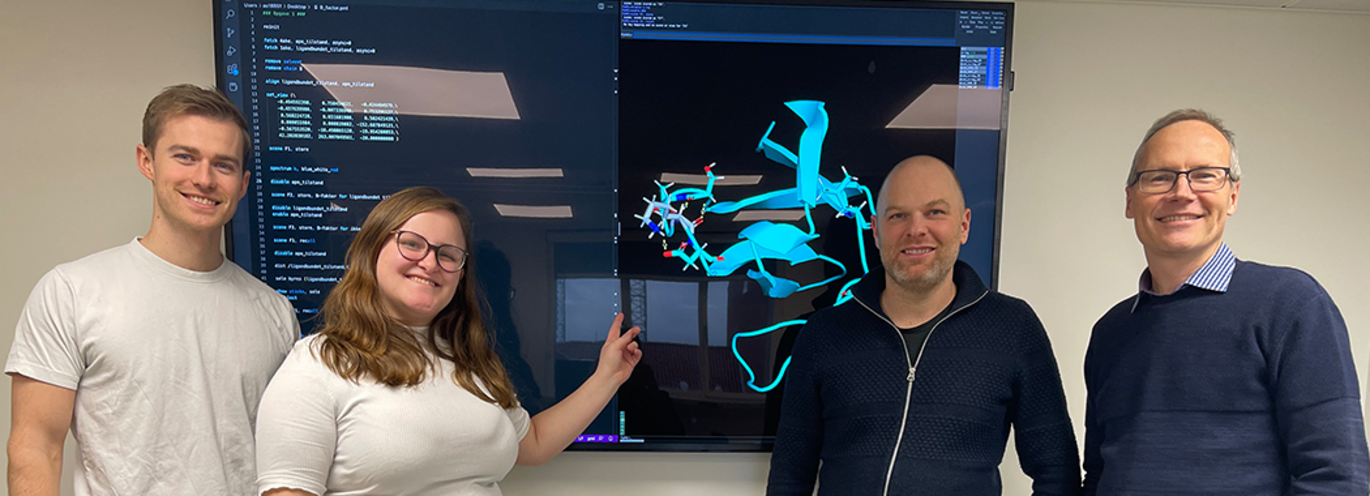Teachers team up with students to integrate programming into teaching
A group of teachers at the Department of Molecular Biology and Genetics at Aarhus University has joined forces with former students to develop the teaching of structural biology. The result is a whole new way of teaching computer skills, and it has been well received by new students.

Programming is well underway to become one of the core competences in future science educations. But programming is more than just codes and syntax. It is also a way of thinking - "computational thinking" - the art of thinking and expressing problems so that they can be solved by a computer. And in a new development project, teachers at the Department of Molecular Biology and Genetics (MBG) have integrated programming and "computational thinking" into the teaching of structural biology.
"Teaching programming is different from a lot of the other curriculum material we cover on the course. When I teach enzyme kinetics, for example, all the students start from the same level. But when we teach programming, there is a huge difference between the levels of the individual students", says Associate Professor Magnus Kjærgaard, who is one of the initiators of the project. "That is why it also requires a different approach to teaching".
On the course Biomolecular Structure and Function at MBG – which is taken each year by approx. 130 students in molecular biology, molecular medicine, and medicinal chemistry – programming as part of advanced, structural analysis of biological macromolecules, is a core topic. It's a difficult subject matter, so in an attempt to improve teaching of programming skills, the teachers applied for an Edu-IT development project, which was supported by the Faculty of Natural Sciences at Aarhus University where they collaborated directly with former students of the course to develop the teaching material that best supports the students at their level.
This has resulted in a completely new learning path and a scientific article that has just been published in the international journal, The Biophysicist. The involvement of former students in the planning of teaching has, among other things, resulted in a number of instructional videos and a complete set of written practical exercises that support different learning styles.
Former students are involved in teaching development
"We really believe that our former students are a goldmine that can be used to improve and further develop teaching", says Professor Ditlev Brodersen, who is one of the other initiators and responsible for the Edu-IT project. "As an experienced teacher, it can be extremely difficult to understand exactly what challenges the students who are in the process of learning something new have. And here the former students, who have recently gone through the learning process, have a completely unique perspective.”
"It has been an overwhelmingly positive experience, and we could easily see that this model could contribute significantly to the development of teaching, not just at our department, but broadly at both the faculty and the university", adds Ditlev Brodersen. In addition to teachers on the course Biomolecular Structure and Function, the team behind the new work also comprises of two former students on the course, Laura Skak Rasmussen and Johan Nygaard Vinther, who both have bachelor's degrees in molecular medicine and are now pursuing master's degrees in bioinformatics.
After the initial testing of the new teaching elements in the autumn of 2021, the teaching team carried out a thorough evaluation of the students' experience as well as a concrete test of how good the learning had been. "We can see that the students really welcome the new teaching elements, especially the more structured approach to learning, and that more than half have the experience that they get really good support", says Magnus Kjærgaard, who is first author of the scientific article.
"Furthermore, with our test, we can gain quite a precise insight into how many students achieve which levels of competence and thus also understand where we need to invest additional effort in teaching", he continues. The quantitative data that has come out of the study shows, among other things, that almost 75% of the participating 123 students are able to complete even the most advanced tasks they were presented with after completing the course. "In all modesty, we are actually quite satisfied with that", concludes Magnus Kjærgaard.
More information
Associate Professor Magnus Kjærgaard - magnus@mbg.au.dk
Professor Ditlev Brodersen - deb@mbg.au.dk - mobile: +45 2166 9001
Department of Molecular Biology and Genetics
Aarhus University, Denmark
